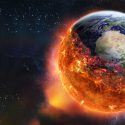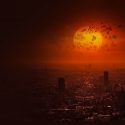Black holes are the gravitational monsters of the Universe. They are so powerful that nothing, even light, can escape their grasp.
One black hole is bad enough. But if you took two black holes and smashed them into each other, they’d be capable of changing the shape of space itself.
How epic would that explosion be? And could it somehow reach the Earth?
Of course, we have no means to capture or control black holes yet. So, imagine you’re observing one from a giant telescope here on Earth. And suddenly, you notice something strange.
Is that another black hole? It sure looks like it. And it also looks like these two are about to collide.
It turns out that even such gravitational giants as black holes occasionally run into each other in the seemingly vast Universe. Are you about to see a nuclear bomb-like explosion of supersize proportions?
The reality might be a little disappointing. But you still wouldn’t want that galactic bomb to detonate anywhere near your planet. Bear with me here, because to understand how black holes collide, you need to arm yourself with a bit of theory.
Black holes come in all shapes and sizes. And, of course, the magnitude of the collision would depend on which black holes are slammed together.
Stellar-mass black holes are the most common type. They can have up to 20 solar masses, but could fit in a ball much smaller in diameter than our Sun.
Now, let’s go back to you observing this gravitational show firsthand. First, you’d see the two black holes getting a little closer, until they started to orbit each other.
As they were circling around, they would begin pulling matter and gas into a vortex between them. Get comfortable, because it could take billions of years for their centers to merge. But as the black holes merged into one, they’d wobble a little, and settle into a new, bigger black hole.
I hope you aren’t disappointed with such an explosion-free outcome. But wait, there is something I haven’t mentioned yet. The excess energy from the collision would be expelled back into the Universe as gravitational waves.
As I mentioned before, colliding black holes can change the shape of the space around them. They do it by rippling this space with gravitational waves.
Albert Einstein predicted gravitational waves over a hundred years ago. But scientists didn’t observe them until 2015, when the advanced LIGO gravitational-wave observatory finally detected gravitational waves after 8 years of operation.
The cool thing about these waves is that they affect the distance between the Sun and the Earth. But they only change it by the diameter of a hydrogen atom. You’d need a whole lot of colliding black holes to really see a difference.
But what about supermassive black holes? Would their collision be more explosive? These black holes have a mass of at least hundreds of thousands of times the mass of our Sun. And the thing is, they might not even collide at all.
Two supermassive giants would get close to each other until they reached a gravitational balance, and froze in their respective orbits. But add another supermassive black hole to the equation, and the three of them could tip over the gravitational scale and, finally, collide. Not in a massive cosmic explosion, but a silent merger, sending powerful gravitational waves throughout the Universe.
Despite the fact that black holes are an unstoppable, insatiable force from which nothing can escape, we have nothing to fear from their collision. Okay, maybe if that collision happened somewhere in the neighborhood of our Solar System. Then the merging black holes would rip all the planets in their vicinity to shreds, including Earth.
Sources
- “Neil deGrasse Tyson Describes The ‘Morbidly Funny’ Death You’d Experience In A Black Hole”. Ryan Buxton, 2015. huffingtonpost.ca. Accessed January 21 2020.
- “What Happens When Two Black Holes Collide?”. Ryan F. Mandelbaum, 2020. Gizmodo. Accessed January 21 2020.
- “See What a Black Hole Would Do to Earth with Online ‘Collision Calculator”. Wall, Mike. 2019. space.com. Accessed January 21 2020.
- “Black Hole Collision Calculator”. Álvaro Díez, 2020. omnicalculator.com. Accessed January 21 2020.
- “Instant Expert: General Relativity”. 2020. New Scientist. Accessed January 21 2020.
- “What Happens When Planets, Stars, And Black Holes Collide?”. Ethan Siegel, 2018. Medium. Accessed January 21 2020.
- “Gravitational Waves Observed”. 2020. news.gatech.edu. Accessed January 21 2020.
- “Space Place in a Snap: What Is a Black Hole?”. 2020. NASA/JPL Edu. Accessed January 21 2020.
- “What happens when black holes collide?”. Fraser Cain, 2016. phys.org. Accessed January 21 2020.



























